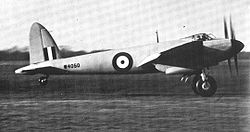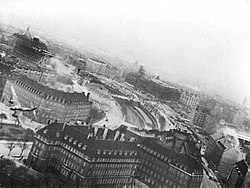De Havilland Mosquito
The De Havilland Mosquito is a British aircraft from the World War II. The Mosquito was a successful design. Originally intended to be a bomber, the type was very fast, could fly a long way and carry heavy loads. Therefore, it was and it was adapted to a number of other roles such as fighter, night fighter, night intruder, attack, reconnaissance and pathfinder.
| DH.98 Mosquito | |
|---|---|
| Mosquito B Mk IV serial DK338 before delivery to 105 Squadron. This aircraft was used on several of 105 Squadron's low-altitude daylight bombing operations during 1943. | |
| Role | |
| National origin | United Kingdom |
| Manufacturer | de Havilland Aircraft Company |
| First flight | 25 November 1940[1] |
| Introduction | 15 November 1941[2] |
| Retired | 1963 |
| Status | Retired |
| Primary users | Royal Air Force |
| Produced | 1940–1950 |
| Number built | 7,781[3] |
| Unit cost | £9,100 (1951) [4] |
De Havilland Mosquito Media
Construction concepts pioneered in the DH.88 Comet were later used in the Mosquito.
One of de Havilland's proposals was to adapt the de Havilland Albatross design to create a fast bomber.
W4050 being restored at the de Havilland Aircraft Heritage Centre near St Albans
A preserved Mosquito at the U.S. Air Force Museum (former TT Mk.35 which was restored to B Mk.XVI configuration). Note the air and oil coolant radiators in the leading edge of the wing, intake for the two-stage Merlin's intercooler radiator behind the propeller blade, and the carburettor intake with ice guard behind and below.
American F-8 Mosquito nose; USAAF markings, PRU Blue finish at the National Museum of the United States Air Force.
Bombing of the Gestapo headquarters in the Shellhus, Copenhagen, Denmark, in March 1945. A Mosquito pulling away from its bombing run is visible on the extreme left, centre.
References
- ↑ Bowman 2005, p. 8.
- ↑ "RAF - RAF Timeline 1941". Archived from the original on 8 July 2015. Retrieved 11 July 2015.
- ↑ Bowman 2005, p. 163.
- ↑ Hartley, Keith (2014-11-28). The Political Economy of Aerospace Industries: A Key Driver of Growth and International Competitiveness?. Edward Elgar Publishing. ISBN 978-1-78254-496-8.









